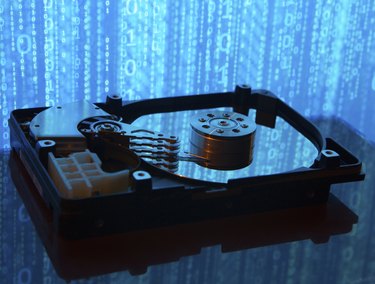
If you have ever noticed that your available hard disk space is significantly lower than the total capacity of the disk, you are not alone -- often, your system drive will indeed have unused space on it, and in some cases this unused space is truly unallocated disk space that you can reclaim toward your total hard drive capacity. Other times, though, this space is reserved as a recovery partition or for some other purpose. In both cases, you can recover this unallocated space for use on your system disk, but you have to be careful.
Step 1
Open up the Windows Disk Management utility. Open the Start screen or Start menu, type "diskmgmt.msc" and choose Disk Management from the results.
Video of the Day
Step 2
Identify your system disk. In the bottom pane of the screen, the physical disks attached to your computer are listed on the left side.
Step 3
Identify the partitions on your system disk. The partitions are shown to the right of the disks. You should see the drive letters that are visible from Windows (e.g. C: and D:). The partitions you want to reclaim space from are the ones on your system disk without drive letters assigned.
Step 4
If the partition is shown as "unallocated space" or "free space," you can safely extend your system volume or another volume to use this space. Proceed to Step 7.
Step 5
If a partition shows something similar to "Healthy (Active, Primary Partition)" but does not have a drive letter, it is likely a system recovery partition. This can be deleted, but make sure that you have created external recovery media to use in lieu of the recovery partition (see Resources). Right-click the partition and choose "Delete Volume…" You will be warned that all data on that drive will be deleted. Ensure that you have backed up all your important data on that disk and click "Yes." The partition will now be shown as unallocated space. Proceed to Step 7.
Step 6
If the partition is labeled "System Reserved," this partition contains boot files and BitLocker Encryption startup files. Do not delete this using the Disk Management utility. The System Reserved partition is usually only a couple hundred megabytes and the benefits of reclaiming this space do not usually outweigh the risks. If you still wish to reclaim this space, see "Understand (and Get Rid of) the Mysterious Small Partition" in Resources.
Step 7
Determine the positon of the unallocated space. If the unallocated space is after an existing partition with a drive letter, proceed to the next step. If the unallocated or free space is first on the disk, you cannot use Windows Disk Management utility to recover the space. However, you can use EaseUS Partition Master Free, GParted, or Paragon Partition Manager to reclaim the unallocated space. See links in Resources.
Step 8
Right-click the volume that precedes the unallocated space and click "Extend volume…" to open the "Extend Volume Wizard" dialog.
Step 9
Keep the default settings in order to use all the available free space. Confirm that your system disk (usually Disk 0) is in the Selected column and that the "Select the amount of space in MB" field matches the "Maximum available space in MB" field.
Step 10
Click "Next" and then click "Finish." Your partition will now be extended to use the unused disk space.
Step 11
Restart your computer. If your system cannot find the boot volume after restarting, insert your recovery media or your Windows installation disc to repair Windows without losing your data. Make sure you select "Repair" instead of "Install" if you are using the Windows installation disc.
Video of the Day
- EaseUS: How to Extend System Partition (C: Drive) to Optimize Performance of Your Computer?
- Windows Server: Extend a Basic Volume
- Paragon Software Group: Partition Manager Home 14 User Manual
- Gnome Partition Editor: GParted Manual
- EaseUS Partition Master Free
- Runtime Software: DriveImage XML
- R-tools Technology: R-Drive Image
- Windows: Create a USB recovery drive
- TechNet Magazine: Understand (And Get Rid of) the Mysterious Small Partition
- Paragon Software Group: Paragon Partition Manager
- Windows: Back Up Your Programs, System Settings, and Files
- Clonezilla: What Is Clonezilla?
- Gnome Partition Editor: About